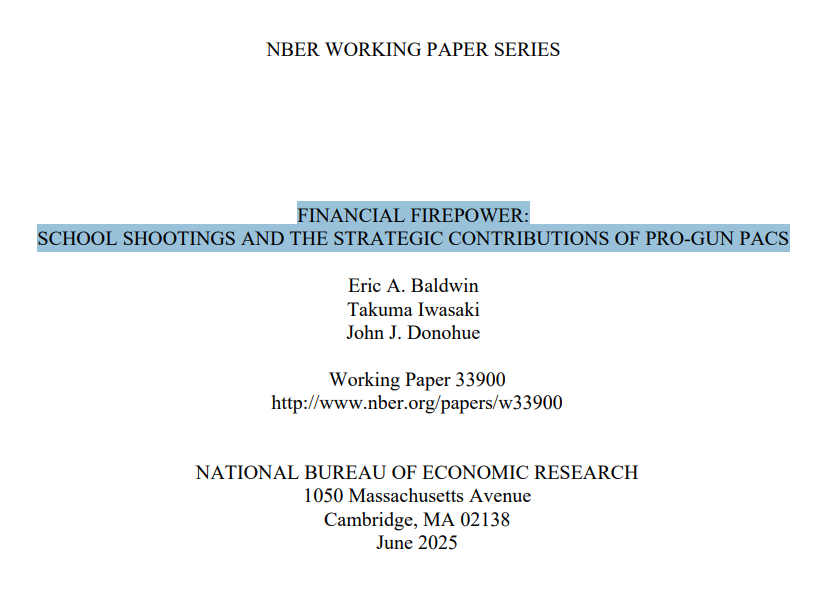New research papers on the effects of school shootings
Looser gun laws increase child deaths, fatal school shootings increase pro-gun PAC donations to congressional districts, and school shootings decrease retail spending for 6 months after an attack.
New research shows that school shootings trigger political donations, shift community spending, and expose deep impacts of American gun culture. These findings aren’t memes posted on social media or conjecture from elected officials, they come from peer-reviewed articles in major academic journals.
These four new studies show just how far the ripple effects of school shootings reach. A team of Stanford law professors found that pro-gun PACs dramatically ramp up campaign contributions by more than 1700% when a fatal school shooting happens close to Election Day. A JAMA Pediatrics study links permissive firearm laws to thousands of excess child deaths, especially in states that loosened restrictions after 2010. New social science research examines how many school shooters saw guns not just as weapons, but rather felt that their gun was their only friend. A marketing research paper finds that communities that experience a school shooting spend less on groceries and restaurants for up to six months, especially in politically liberal areas.
These studies paint a complex picture of how gun violence at schools intersects with politics, policy, sociology, and the economy.
FINANCIAL FIREPOWER: SCHOOL SHOOTINGS AND THE STRATEGIC CONTRIBUTIONS OF PRO-GUN PACS
New National Bureau of Economic Research paper by three Stanford law professors using the K-12 School Shooting Database.
To prevent political fallout, do pro-gun Political Action Committees increase contributions after fatal school shootings?
Leveraging a novel dataset of pro-gun PAC contributions and school shooting incidents, the authors implement a difference-in-differences design with staggered treatment adoption to estimate the causal effect of school shootings on pro-gun PAC contributions to House candidates.
Pro-gun PACs increase contributions by 30.2% to candidates in districts with fatal school shootings, but show no significant response to non-fatal school shootings.
If a fatal school shooting happens within two months of Election Day, pro-gun PAC contributions increase by 1730%.
The findings provide robust evidence that pro-gun PACs deploy targeted financial contributions in response to school shootings, with the magnitude and timing suggesting a strategic counter-mobilization effort to maintain influence in affected districts when gun policy becomes locally salient and elections are near.
Firearm Laws and Pediatric Mortality in the US
A new article in JAMA Pediatrics questions if states enacting permissive firearm laws after 2010—when McDonald v Chicago was decided by the US Supreme Court—subsequently experience higher rates of pediatric firearm mortality?
Findings: Excess mortality analysis found that a group of states with the most permissive firearm laws after 2010 experienced more than 6029 firearm deaths in children and adolescents aged 0 to 17 years between 2011 and 2023 and 1424 excess firearm deaths in a group of states with permissive laws. In the most permissive states, the largest increase occurred in the non-Hispanic Black pediatric population; among all states, 4 states had statistical decreases in pediatric firearm mortality during the study period, all of which were in states with strict firearm policies.
These results demonstrate that permissive firearm laws contributed to thousands of excess firearm deaths among children living in states with permissive policies; future work should focus on determining which types of laws conferred the most harm and which offered the most protection.
“The only friend I had was my gun”: A mixed-methods study of gun culture in school shootings
Firearms are the leading cause of death for minors in the United States and US gun culture is often discussed as a reason behind the prevalence of school shootings. Yet, few studies systematically analyze if there is a connection between the two: Do school shooters show a distinct gun culture?
This article studies gun culture in action in school shootings. It studies if school shooters show distinct meanings and practices around firearms prior to the shooting, as well as patterns in access to firearms. To do so, I analyze a full sample of US school shootings. Relying on publicly available court, police, and media data, I combine qualitative in-depth analyses with cross-case comparisons and descriptive statistics.
Findings suggest most school shooters come from a social setting in which firearms are a crucial leisure activity and hold meanings of affection, friendship, and bonding. These meanings translate into practices: all school shooters had easy access to the firearms they used for the shooting. Findings contribute to research on firearms and youth violence, public health, as well as the sociology of culture.
Journal of Marketing Research: How Fatal School Shootings Impact a Community’s Consumption
School shootings are a disturbingly regular occurrence in the US. While their direct impact on those involved are well-researched, their broader effects on communities are less understood. This new paper focuses on the under-researched question of how such traumatic incidents affect community consumption. Using data from various sources, we find that fatal school shootings decreased grocery purchases by 2.09% in affected communities, lasting up to 6 months.
This economic impact is felt more in liberal than conservative-leaning counties. Additionally, extended analysis reveals that these incidents reduce spending at food services and drinking places by 8% and at food and beverage stores by 3%. Three experimental studies provide evidence that this decrease is driven by heightened anxiety around consumption in public spaces, particularly for political liberals. Our work suggests the violence has far-reaching consequences, harming the local economy.
The decline in spending highlights the need for community leaders to develop supportive community responses to such horrific incidents, in addition to the resources currently offered to the victims and their families.
David Riedman is the creator of the K-12 School Shooting Database, Chief Data Officer at a global risk management firm, and a tenure-track professor. Listen to my weekly podcast—Back to School Shootings—or my recent interviews on Freakonomics Radio, New England Journal of Medicine, and my article on CNN about AI and school security.







